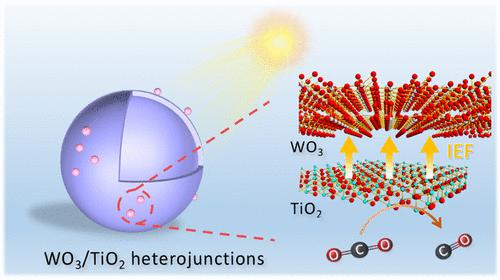当前位置:
X-MOL 学术
›
Inorg. Chem.
›
论文详情
Our official English website, www.x-mol.net, welcomes your
feedback! (Note: you will need to create a separate account there.)
Boosting Interfacial Charge Transfer with a Giant Internal Electric Field in a TiO2 Hollow-Sphere-Based S-Scheme Heterojunction for Efficient CO2 Photoreduction
Inorganic Chemistry ( IF 4.3 ) Pub Date : 2022-08-18 , DOI: 10.1021/acs.inorgchem.2c02443 Haiwei Su 1 , Weikang Wang 1 , Haopeng Jiang 1 , Lijuan Sun 1 , Tingting Kong 2 , Zhongxi Lu 1 , Hua Tang 3 , Lele Wang 1 , Qinqin Liu 1
Inorganic Chemistry ( IF 4.3 ) Pub Date : 2022-08-18 , DOI: 10.1021/acs.inorgchem.2c02443 Haiwei Su 1 , Weikang Wang 1 , Haopeng Jiang 1 , Lijuan Sun 1 , Tingting Kong 2 , Zhongxi Lu 1 , Hua Tang 3 , Lele Wang 1 , Qinqin Liu 1
Affiliation

|
The construction of an S-scheme charge transfer pathway is considered to be a powerful way to inhibit charge recombination and maintain photogenerated carriers with high redox capacity to meet the kinetic requirements of the carbon dioxide (CO2) photoreduction reaction. For an S-scheme heterojunction, an internal electric field (IEF) is regarded as the main driving force for accelerating the interfacial spatial transfer of photogenerated charges. Herein, we designed a TiO2 hollow-sphere (TH)-based S-scheme heterojunction for efficient CO2 photoreduction, in which WO3 nanoparticles (WP) were applied as an oxidation semiconductor to form an intimate interfacial contact with the TH. The S-scheme charge transfer mode driven by a strong IEF for the TH/WP composite was confirmed by in situ X-ray photoelectron spectroscopy and ultraviolet photoelectron spectroscopy. As a result, abundant photogenerated electrons with strong reducing ability would take part in the CO2 reduction reaction. The combination of surface photovoltage spectra and transient photocurrent experiments disclosed that the IEF intensity and charge separation efficiency of the fabricated TH/WP composite were nearly 16.80- and 1.42-fold higher, respectively, than those of the pure TH. Furthermore, sufficient active sites provided by the hollow-sphere structure also enhanced the kinetics of the catalytic reaction. Consequently, the optimized TH/WP composite showed a peak level of CO production of 14.20 μmol g–1 in 3 h without the addition of any sacrificial agent. This work provides insights into the kinetic studies of the S-scheme charge transfer pathway for realizing high-performance CO2 photoreduction.
中文翻译:

在基于 TiO2 空心球的 S 型异质结中利用巨大的内部电场促进界面电荷转移,以实现高效的 CO2 光还原
S型电荷转移通路的构建被认为是抑制电荷复合并保持具有高氧化还原能力的光生载流子以满足二氧化碳(CO 2 )光还原反应的动力学要求的有效方法。对于S型异质结,内部电场(IEF)被认为是加速光生电荷界面空间转移的主要驱动力。在此,我们设计了一种基于 TiO 2空心球 (TH) 的 S 型异质结,用于高效的 CO 2光还原,其中 WO 3纳米颗粒(WP)用作氧化半导体以与TH形成紧密的界面接触。原位X 射线光电子能谱和紫外光电子能谱证实了强 IEF 驱动的 TH/WP 复合材料的 S 型电荷转移模式。结果,大量具有强还原能力的光生电子将参与到CO 2中。还原反应。表面光电压光谱和瞬态光电流实验的结合表明,制造的 TH/WP 复合材料的 IEF 强度和电荷分离效率分别比纯 TH 高出近 16.80 倍和 1.42 倍。此外,空心球结构提供的足够活性位点也增强了催化反应的动力学。因此,优化的 TH/WP 复合材料在不添加任何牺牲剂的情况下,在 3 小时内的 CO 产生峰值水平为 14.20 μmol g –1 。这项工作为实现高性能 CO 2光还原的 S 型电荷转移途径的动力学研究提供了见解。
更新日期:2022-08-18
中文翻译:

在基于 TiO2 空心球的 S 型异质结中利用巨大的内部电场促进界面电荷转移,以实现高效的 CO2 光还原
S型电荷转移通路的构建被认为是抑制电荷复合并保持具有高氧化还原能力的光生载流子以满足二氧化碳(CO 2 )光还原反应的动力学要求的有效方法。对于S型异质结,内部电场(IEF)被认为是加速光生电荷界面空间转移的主要驱动力。在此,我们设计了一种基于 TiO 2空心球 (TH) 的 S 型异质结,用于高效的 CO 2光还原,其中 WO 3纳米颗粒(WP)用作氧化半导体以与TH形成紧密的界面接触。原位X 射线光电子能谱和紫外光电子能谱证实了强 IEF 驱动的 TH/WP 复合材料的 S 型电荷转移模式。结果,大量具有强还原能力的光生电子将参与到CO 2中。还原反应。表面光电压光谱和瞬态光电流实验的结合表明,制造的 TH/WP 复合材料的 IEF 强度和电荷分离效率分别比纯 TH 高出近 16.80 倍和 1.42 倍。此外,空心球结构提供的足够活性位点也增强了催化反应的动力学。因此,优化的 TH/WP 复合材料在不添加任何牺牲剂的情况下,在 3 小时内的 CO 产生峰值水平为 14.20 μmol g –1 。这项工作为实现高性能 CO 2光还原的 S 型电荷转移途径的动力学研究提供了见解。


















































 京公网安备 11010802027423号
京公网安备 11010802027423号